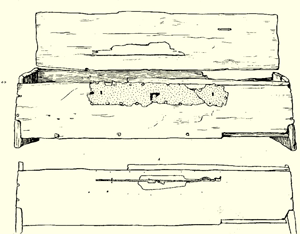The Mästermyr chest is made of oak planks measuring 89 x 26 x 24 cm (length x width x height). The lid has a convex top, reinforced with two broad iron bands across it. The hinges on the back consist of two double iron staples. When it was found, the chest was wrapped in an iron chain, both as an extra lock and as a replacement for the handle, which seems somewhat insufficient for the great weight of the chest. See the picture below.

The lock on the chest
The front of the chest has a long, wide lock plate of hammered iron. A lock and bolt are mounted inside the plate. Two braided iron bands extended from iron staples were attached to the lid. The other end of the bands had hasps that fit into the two openings in the plate, where they were locked in place by the bolt. Both the iron bands and the hasps are missing.
Contents of the chest
The tools in the chest are quite astonishing, both in terms of quantity and areas of use. Smiths manufactured their own tools based on existing models, and of course they also inherited some. Many of them are strikingly similar to Roman tools on display in several museums in parts of Germany that were once controlled by Rome, and were probably inspired by them.
Chest locks, padlocks, keys, escutcheons and springs
The tools were Roman in style (see pictures from the Roman citadel of Saalburg). Keys and locks were also influenced by their Roman counterparts. The political expansion of the Roman Empire had a long history of direct or indirect trade with foreign countries far from the empire’s boundaries. Technological ideas were spread over large parts of the known world.
The storage chest contained eleven padlocks and lock parts and keys as shown in fig. 19.
Key with four-tooth bit at a right angle from the shaft. Fig. 19:2. The upper part of the shaft is spool-shaped and consists of eight braided iron threads held together by a bronze ring. Total length 21.4 cm
Key of iron with three-tooth bit at a right angle to the shaft. Fig. 19:3. A wooden handle is mounted on the top of the shaft. Total length 19.6 cm.
Lock fitting of iron. Fig. 19:4. A row of small, square notches matches the teeth on the bit of the one key. 9.6 x 4.5 cm.
Lock fitting of iron. Fig. 19:5. Lock plate. Two rows of small notches are possibly keyholes. 7.3 x 5.2 cm.
Lock spring of iron. Fig. 19:6. One of three spring plates still remains. 15.1 x 2.4 cm.
Lock spring of iron. Fig. 19:7. Three spring plates, one broken off. 10.1 x 3.1 cm.
Lock spring of iron. Fig. 19:8. Bent back with three spring plates, one broken off, with a ring for hanging. 10.5 x 2.7 cm.
Lock spring of iron. Fig. 19:9. Bent back with three spring plates and a ring for hanging. 9.4 x 1.9 cm.
Padlock of iron with elements of brass soldering. Fig. 19:10. In two parts with three springs; bottom plate missing. Decorated with three twisted iron rods. The keyhole is T-shaped. 4.5 x 3.0 x 2.2 cm.
Padlock of iron. Fig. 19:11. Like 19:10, but somewhat smaller. Only one spring remains. Decorated with twisted iron rods. The keyhole is T-shaped. 4.5 x 3.0 x 2.2 cm.
Padlock of iron. Fig. 19:12. Like 19:10–11, but no springs remain. Decorated with twisted iron rods. 2.8 x 2.2 x 2.6 cm.